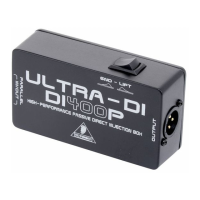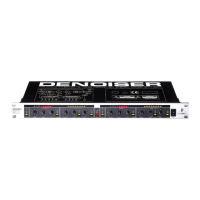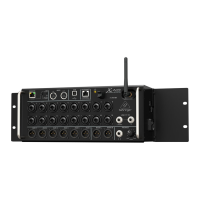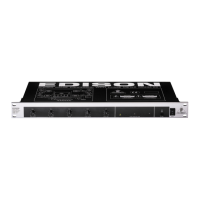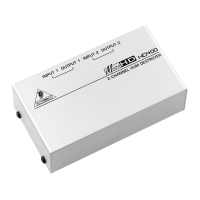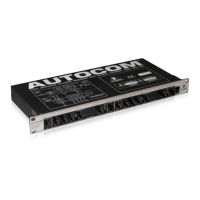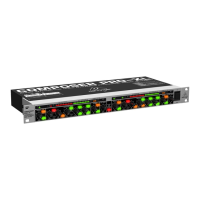9 Quick Start Guide
(EN) Controls
(ES) Controles
(1) OUTPUT. This is the balanced output of the
ULTRA-DIPRO. The connection to the mixing desk
should be made with a standard high-quality
balancedcable.
(2) +20 dB gain switch for pre-amplication of low
levelsignals.
(3) Switchable HIGH CUT lters (8 kHz) for guitar
applications (6 dB/Oct).
(4) With the PHASE REVERSE switch the input signal
isreversed in phase by180°.
(5) Use the GND LIFT switch to either connect the ground
of input and output or keep them completely separate.
Depending on the grounding of the connected
devices linking or disconnecting will reduce hum
or prevent ground loops. GROUND LIFT on means
nointerconnection.
(6) The OUTPUT LEVEL meter displays the output level
ofthe Ultra-DI PRO in a range from -24dB to +18dB.
(7) Use the POWER switch to turn on the BEHRINGER
ULTRA-DI PRO.
(8) LINK. This is the unbalanced parallel output of the
ULTRA-DI PRO. Connectthis to the input of the backline
or monitor amplier.
(9) INPUT. Connect the source to this ¼" jack to input
thesignal.
(10) and (13) The -20 dB ATTENUATION switches greatly
increase the operating range of the ULTRA-DIPRO.
Fromthe low level signals of a high impedance
guitar to the hot speaker terminals of a PA amplier.
Depressingboth will give 40 dB attenuation.
(11) FUSE HOLDER/VOLTAGE SELECTOR.
(12) To provide maximum exibility the ULTRA-DI PRO
isalsotted with an unbalanced XLRINPUT to
connect the source.
Check Out behringer.com for Full Manual
(1) OUTPUT. Salida balanceada (Balanced Output).
Laconexión a una mesa de mezclas debe ser realizada
con un cable estándar de alta calidad.
(2) Selector de ganacia de +20 dB para la
pre-amplicación de señales de bajonivel.
(3) Filtro pasa-bajos conmutable para el uso de la unidad
con guitarras (8kHz,6dB/octava).
(4) Inversión de fase. Pulsando este interruptor la fase de
la señal de entrada se invierte 180°.
(5) Con el interruptor GND LIFT se pueden conectar
las masas de la entrada y la salida o mantenerlas
aisladas. Dependiendo de los dispositivos conectados
la cantidad de ruido puede ser menor en una de las dos
posiciones y también se pueden evitar lazos de tierra.
GND LIFT encendido indica desconexión de las masas.
(6) Medidor del nivel de salida. El rango es de -24 dB a
+18dB.
(7) Iterruptor de encendido del equipo.
(8) LINK. Salida en paralelo no balanceada (asimétrica).
(9) INPUT. Entrada.
(10) y (13) Los interruptores de atenuación de 20 dB
incrementan en gran medida la exibilidad del
ULTRA-DI PRO. De esta forma pueden ser conectadas
desde señales de nivel bajo y alta impedancia como
una guitarra hasta señales de alto nivel como la salida
de un amplicador de P.A. Seleccionando los dos
interruptores se consigue una atenuación de 40 dB.
(11) FUSE HOLDER/VOLTAGE SELECTOR.
(12) Para una máxima exibilidad la unidad está equipada
con una entrada XLR no balanceada.
Si quiere acceder al manual de instrucciones
completo, vaya a la página web behringer.com
ULTRA-DI PRO DI4000 Controls

